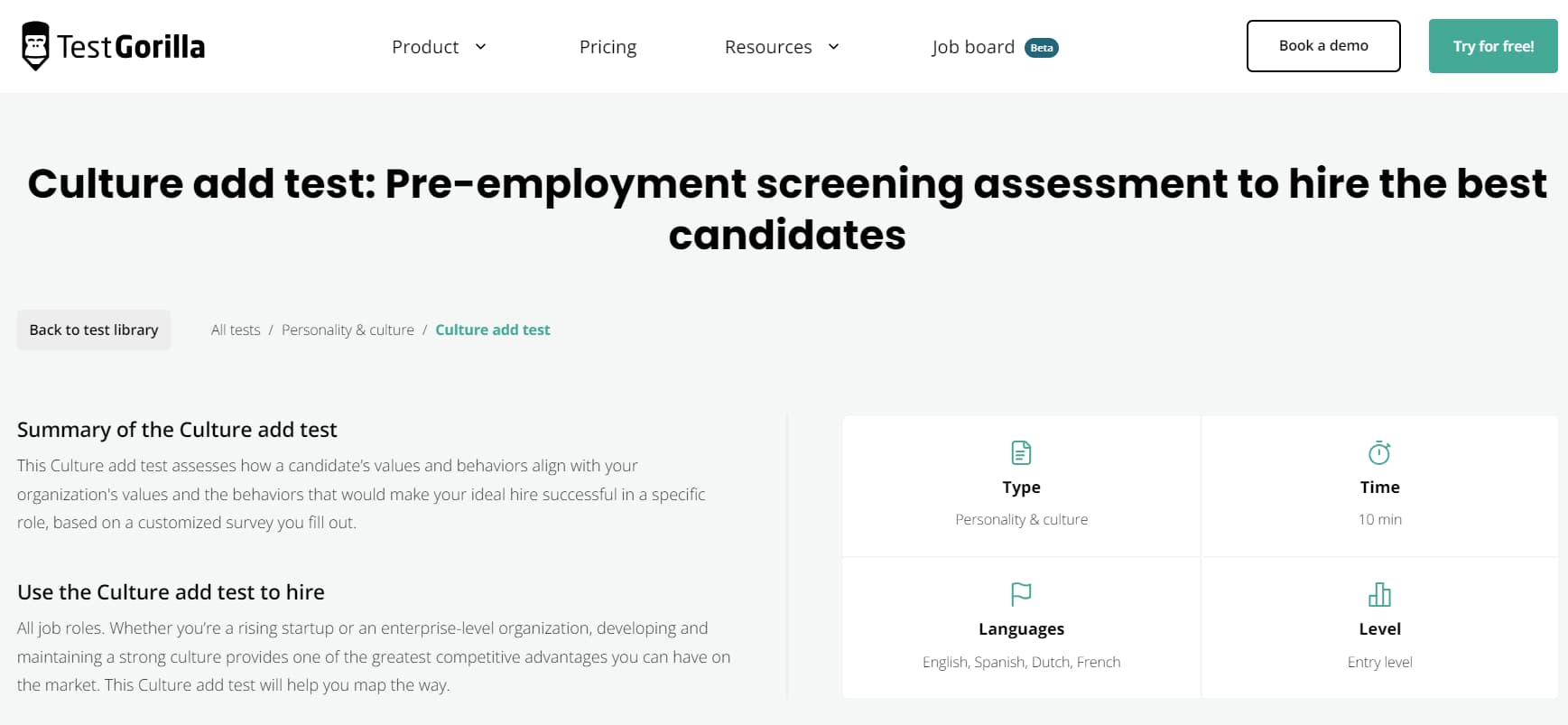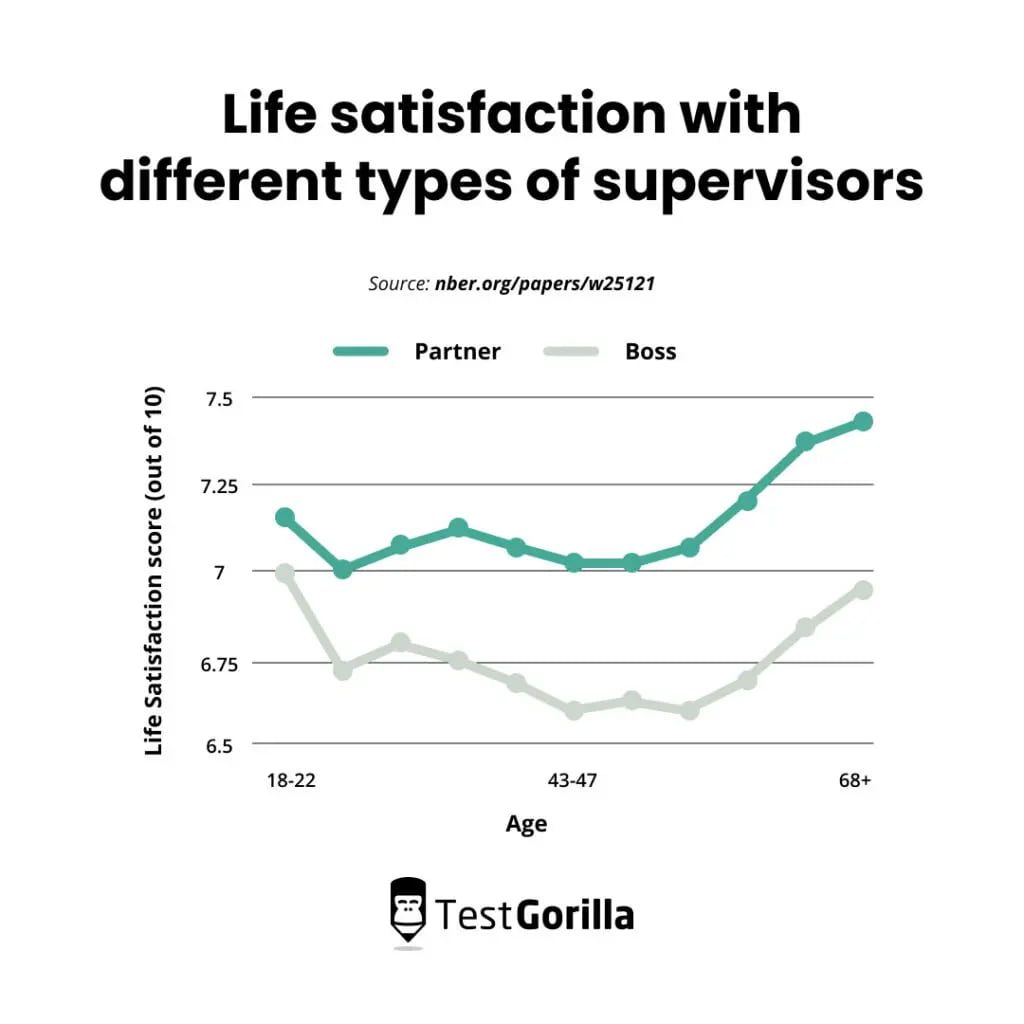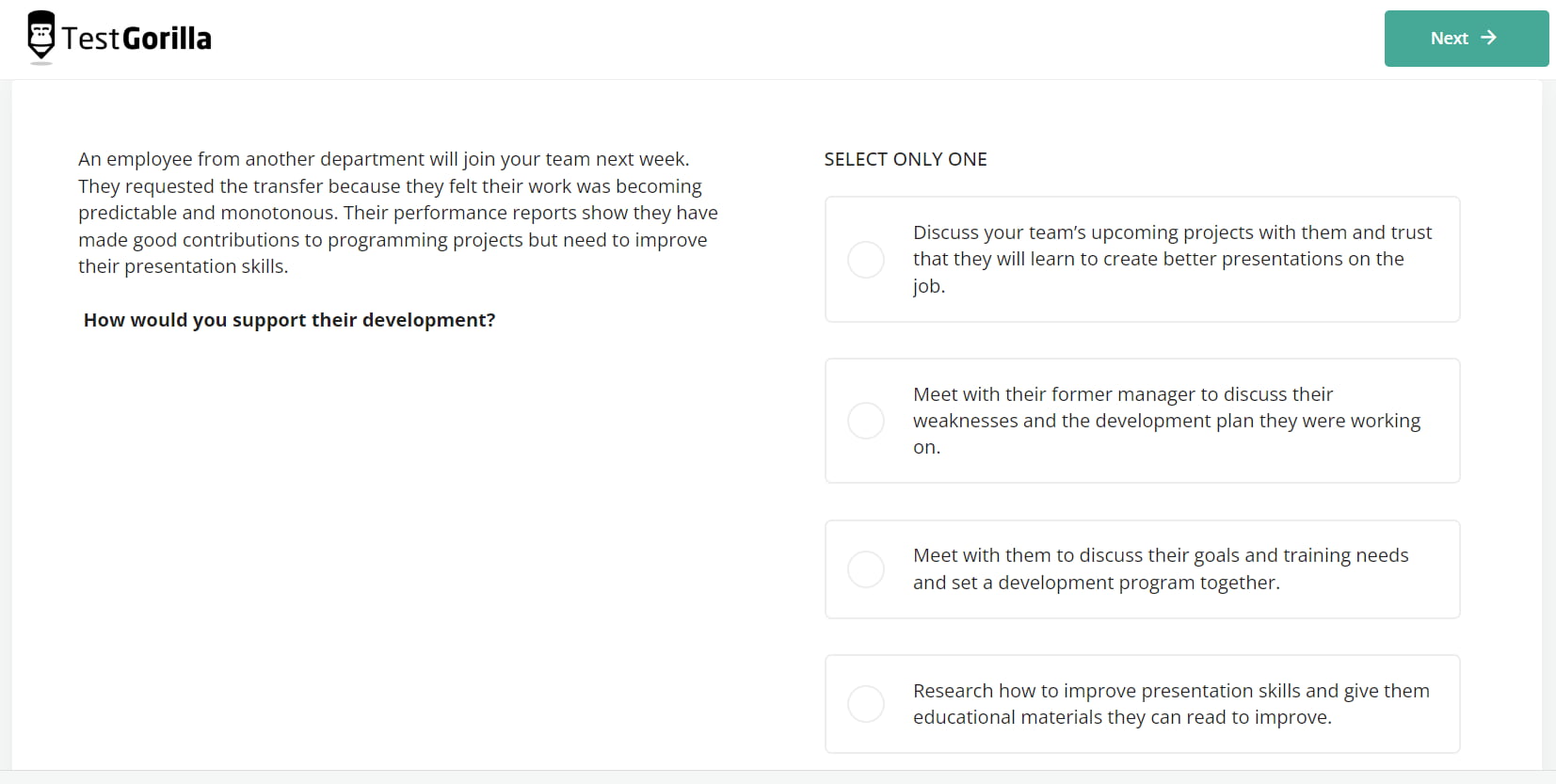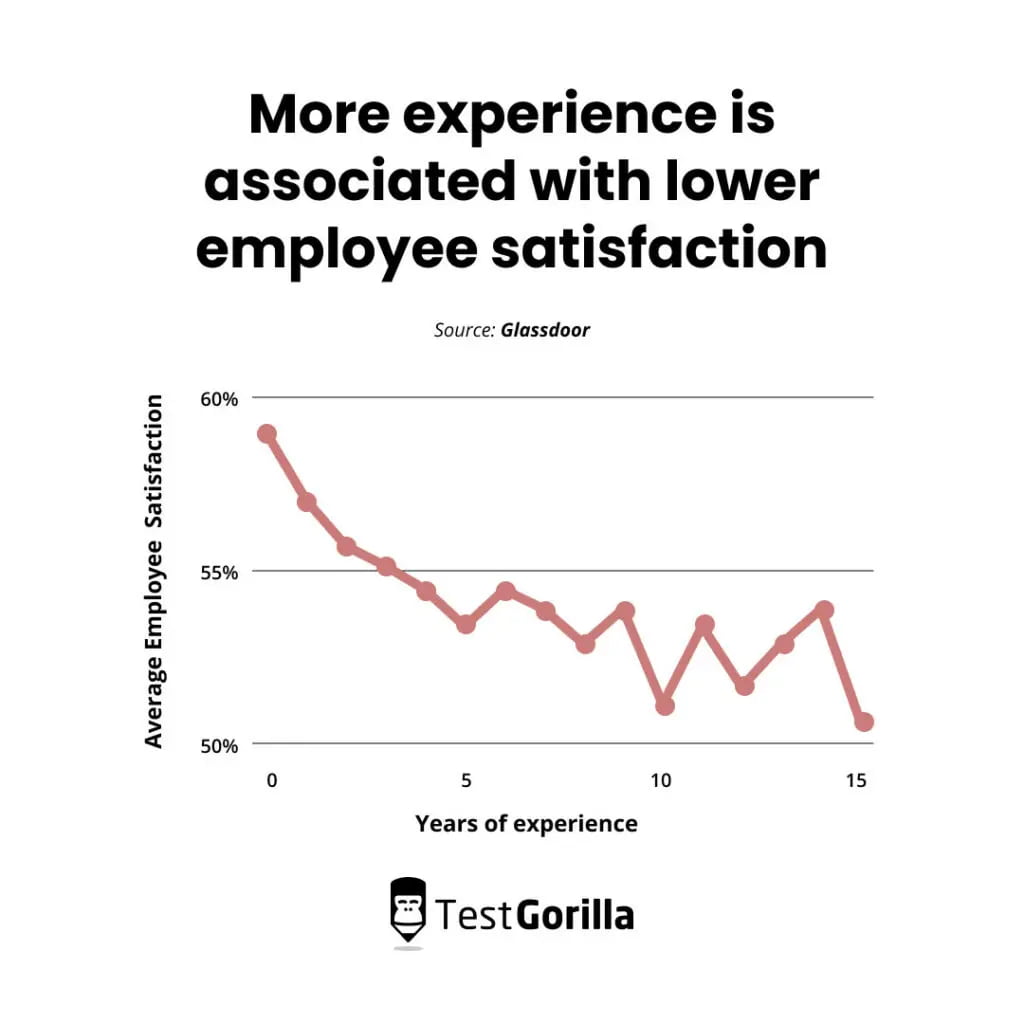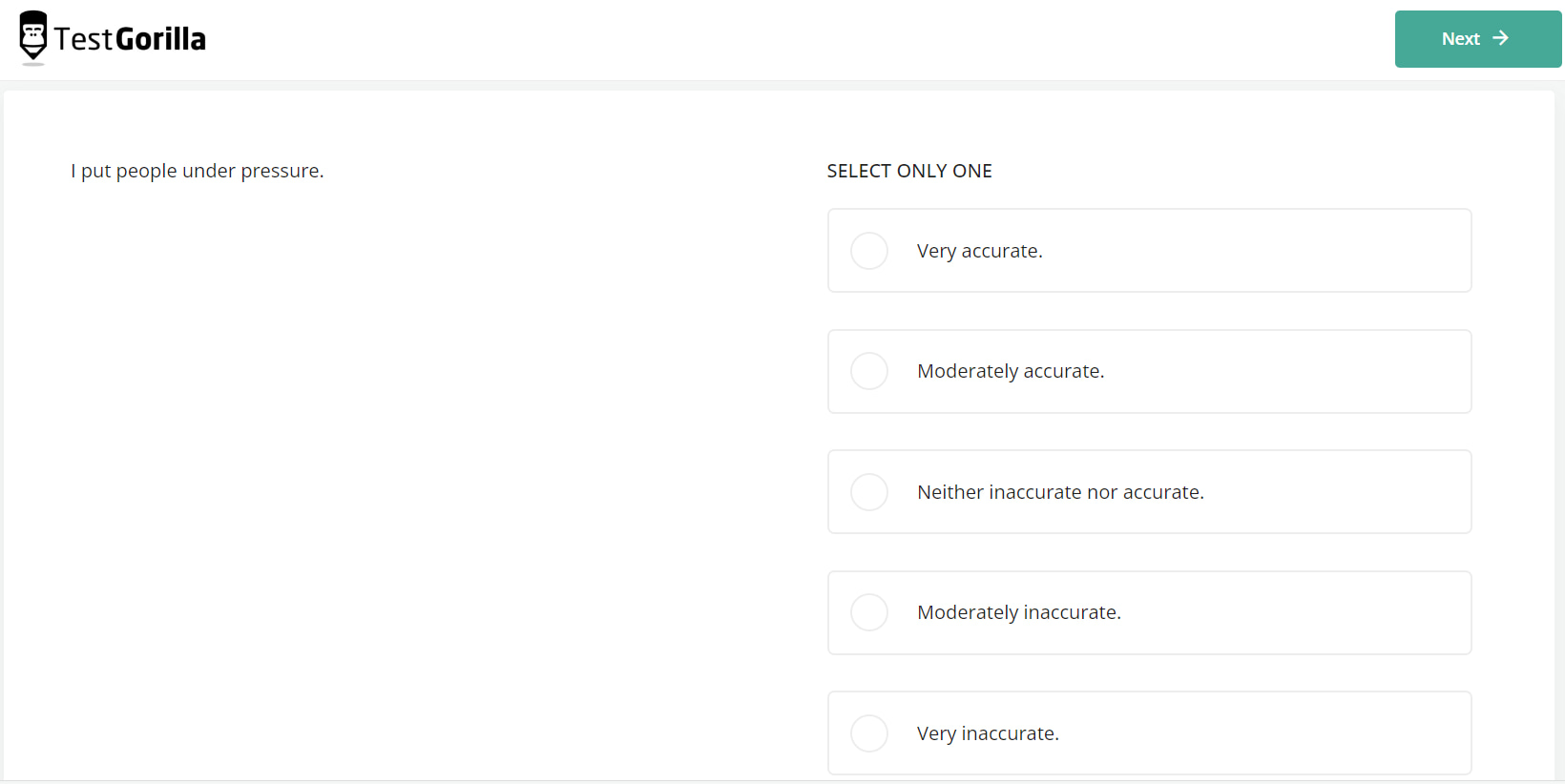10 job satisfaction factors: What matters most to employees?
Job satisfaction directly correlates to employee retention, engagement, and performance.
In other words, worker satisfaction = business success.
Although many employers assume employees’ work satisfaction revolves only around their paychecks, the truth is that you can’t compensate for a poor workplace by just paying more. No matter their salary, employees don’t stay at a workplace that fails to support their development.
In this article, we discuss the importance of job satisfaction. We also examine crucial job satisfaction factors and explore how to use talent assessments to build a more engaged and productive workforce.
What is job satisfaction?
Job satisfaction is the level of contentment employees feel about their work. It encompasses various aspects, such as the nature of the work, the working environment, relationships with colleagues and supervisors, opportunities for personal growth, and recognition for achievements.
So, why is job satisfaction important?
Job satisfaction directly influences employee motivation, productivity, and wellbeing in the workplace. Higher levels of job satisfaction lead to reduced turnover rates, which shows the importance of job satisfaction in creating a stable team that drives organizational success and profitability.
The question we’re all thinking about: “Is employee satisfaction all about money?”
The short answer is no.
The impact of salary on high job satisfaction is relatively small. It influences overall satisfaction but not as much as other employee satisfaction factors.
According to research from the US, France, Germany, Canada, and the UK, compensation and benefits consistently rank in the bottom three sources of job satisfaction for workers.
It’s telling that almost 60% of Americans would work a job they love that pays half their current income rather than a job they hate that pays double their current salary.
Let’s explore the most important factors in job satisfaction.
The best insights on HR and recruitment, delivered to your inbox.
Biweekly updates. No spam. Unsubscribe any time.
The top 10 important factors in job satisfaction
If pay isn’t the be-all and end-all, what job satisfaction perks matter to your human resources and motivate them to put in hard work?
In this section, we describe important factors in employee job satisfaction, their contribution to employee happiness, and how to ensure work satisfaction.
The summary of the most important job satisfaction factors
Here’s a summary for quick reading:
Factor | Benefits |
1. Company culture | A combination of work environment, behavior, values, and attitudes impacts workers’ satisfaction, productivity, and retention |
2. Career opportunities | Employees are more satisfied when you give them opportunities to learn, grow, and achieve their career goals |
3. Senior leadership | Leaders who are helpful and supportive increase job satisfaction |
4. Work-life balance | Workers are more satisfied when they can balance the demands of their work and personal lives |
5. Business outlook | The future of the organization and where it stands in the industry affect career satisfaction |
6. Experience | Experience negatively correlates with employee happiness and engagement |
7. Fair compensation | Unfair compensation is one of the leading causes of employee burnout |
8. Environment and relationships | A positive work environment and good relationships build team camaraderie |
9. Recognition and appreciation | Receiving recognition and acknowledgment impacts morale, engagement, and productivity |
10. Reasonable workload | Excessive workload leads to work-related stress and burnout, which affects job satisfaction |
1. Company culture
Workers are immersed in company culture every day. Work environment, employee behavior, and company policies contribute to an organization’s culture.
Here are a few important elements that factor into company culture:
Shared values
Shared goals
Attitudes
Practices
More organizations prioritize culture by hiring for culture add over culture fit in their recruitment process.
Culture add means hiring a workforce with diverse perspectives and practices to enhance your company culture.
It’s more meaningful than the outdated “beer test” – hiring people with whom you’d feel comfortable going to the pub.
Just as a puzzle doesn’t use 500 of the same pieces, a thriving workplace depends on the combined values, goals, attitudes, and practices of the people working there.
You can use our Culture Add test to determine how people align with your company culture and how they can improve it.
A good company culture helps attract the right people and convinces them to pick your company over other options.
If candidates know your culture, attitude, and initiatives upfront, they’re more likely to stay satisfied, and you’re more likely to reduce voluntary turnover.
A good example is Continental, a food management organization that discovered which sources of job satisfaction most affected employee turnover.
The company’s first attempt at a solution was raising pay rates. It only motivated its competitors to do the same, which drove Continental’s rates up and still didn’t successfully engage and improve workplace satisfaction factors.
So what did the business do? It asked its people what they wanted.
Through the combined ideas and efforts of the employees, HR, and operational leaders, the company overhauled employee incentive programs, production gamification, manager training, and food services. It actively involved its employees in improving sources of job satisfaction, significantly reducing turnover and making employees feel appreciated.
2. Career opportunities
Employees care deeply about career opportunities, growth, and development. The best workers want to learn new skills and get to higher positions.
Offering learning and development opportunities shows that your business supports workers and wants them to achieve their goals. In addition, this factor of job satisfaction helps your organization attract new skilled workers.
A great example of how to support employee career development is Phenom, an HR technology company.
The company:
Advocates internal mobility and career opportunities, supporting transparency and honest discussions about career growth
Clarifies throughout the entire hiring process that growth and development are not only possible but encouraged
These practices helped Lauren Berkel, an employee at Phenom, go from being a sales development rep to a member of the HR team to her current role as a talent experience specialist in about one year.
She says that the company clearly stated throughout the hiring process that the position was great for growth and professional development – and not only in the sales department.
The organization now has a satisfied, high-performing HR professional instead of a somewhat engaged, somewhat satisfied sales development representative.
3. Senior leadership
According to an extensive study of 38,000 workers by the National Bureau of Economic Research, employees’ happiness and career satisfaction were much higher when they had a close partnership with a leader versus a traditional “boss” relationship.
It isn’t surprising that leadership plays a large role in career satisfaction in the workplace because employees engage with leaders often when starting projects, reporting progress, and solving problems.
These tasks take up much of the workweek, so a pleasant, encouraging leader contributes greatly to the work atmosphere.
The best managers are those who:
Lead by example
Promote cooperation
Treat their workers with respect
Recognize employees’ strengths and weaknesses
Offer support
You can improve your employees’ relationship with senior leaders by implementing regular 1:1 meetings in your organization.
Holding one-on-one meetings every one to two weeks gives workers frequent opportunities to:
Express themselves
Discuss important topics like goals and growth
Report problems before they become serious issues
You can also use talent assessments, such as our Leadership and People Management test, to determine whether your senior leaders have the necessary skills to lead their teams effectively.
If you’re interested in how TestGorilla’s talent assessments can help you hire better leaders, sign up for a free demo to learn more.
4. Work-life balance
Employee work-life balance matters to every worker on some level, but it’s critical for a few demographics, such as:
Generation Z
Working parents
People with multiple job roles
People with alternative lifestyles
Upholding and promoting work-life balance is crucial when hiring young workers because 42% of Gen Z workers prioritize work-life balance when job searching.
The same goes for working parents because managing a job and caring for a child can be stressful.
Implementing a flexible working policy is a great way to provide a better work-life balance for all your employees, whether they’re parents or not.
Giving your employees options for different work arrangements, such as remote work, hybrid offices, or flexible working hours, helps them comfortably fit their work schedules into their lives.
This factor of job satisfaction increases engagement, performance, and quality of work because employees’ productivity is higher if they can work when and where they have the most energy.
Encourage your team to prioritize their personal lives by promoting time off and inquiring about their families and hobbies.
Tell your workers about your hobbies and what you do in your free time. It can encourage them to take more time for themselves to relax.
5. Business outlook
Employees want to see their efforts help the company hit targets and grow in the market because a strong company boosts job security.
When your business is successful and recognized by other companies, it creates a sense of safety and reassurance for your workers.
That’s why it’s important to share awards, celebrate record sales or other noteworthy achievements, and thank employees for contributing to these wins.
Employees want to see what the company is working toward, so it’s important to be transparent about your business outlook involving things like:
Growth
Sustainability
Community involvement
Product or service development
A strong, healthy outlook and a clear plan boost employee morale and motivation, increasing productivity and retention.
6. Experience
According to the same Glassdoor study, experience negatively correlates with job satisfaction, meaning that more experienced employees are less satisfied with their work.
This situation could be due to a few key factors:
Factor | Description |
1. Learning about the quality of their work environment over time | Experienced workers have the opportunity to compare many work environments and can be disappointed with the quality of their current work environment. |
2. Becoming tired of their employer or industry as their career progresses | Resentment of one’s work can happen even in great companies, depending on the individual. |
3. Feeling stagnant or disengaged | Many workers grow restless with a lack of challenge and crave stimulation and change. |
4. Being unable to slow down or retire | Fewer people can retire in the modern age. Employees retire later than the previous generation, and some even have to re-enter the workforce to make ends meet. |
5. Making enough money that they don’t see the point anymore | In contrast to the previous point, some older workers are financially comfortable enough that work no longer seems as important. |
So, what’s the solution here?
Acknowledging and using the worker experience improves job satisfaction for these long-standing employees. Ask your employees for their input and insights. Show them that their experience is not only valuable but valued to ensure you have satisfied employees.
For example, you can place these workers on meaningful projects requiring their expertise or offer them coaching and mentoring roles. That helps engage experienced workers and boost their job satisfaction.
7. Fair compensation
Although salary and benefits are not among the top employee satisfaction factors, they are still important. According to 41% of employees, unfair compensation is the number one cause of employee burnout.
Burnout affects performance and engagement, which harms productivity by increasing absenteeism and turnover.
To prevent burnout, pay your workers fairly.
Conduct regular market research to ensure you have competitive salaries and benefits. You should focus on skills-based compensation, considering individual contributions and performance to reflect true value to the organization.
Being transparent about compensation decisions is important because it enhances perceptions of fairness and equality, further boosting job satisfaction and employee retention.
8. Environment and relationships
Strong working relationships create a crucial support network during challenging times, transforming the workplace into a community that supports collaboration.
This sense of belonging and teamwork enhances job satisfaction by making daily tasks more enjoyable and meaningful.
When employees form positive connections at work, they are more likely to share knowledge, leading to innovation and better problem-solving.
You can cultivate a positive work environment by:
Encouraging open communication
Promoting diversity and inclusion
Creating team-building activities
Developing recognition programs
You can also use our DISC Personality test to understand your team members better and develop more helpful collaboration and communication strategies.
Improve your workplace with TestGorilla
Find out how to use TestGorilla's talent assessments to improve your workplace.
Find out how to use TestGorilla's talent assessments to improve your workplace with a free forever account!
9. Recognition and appreciation
Recognition and appreciation in the workplace affirm employees’ values and contributions to the organization. They reinforce their sense of belonging and significance to the team, which supports their motivation and engagement.
The Employee Engagement and Modern Workplace Report by Bonusly reveals that 84% of highly engaged employees received recognition for their previous efforts. It shows the powerful impact of praise and appreciation on employee morale and productivity.
So, how do you create a workplace culture that recognizes and appreciates employees?
Here are a few tips:
Encourage managers and team leaders to provide regular, constructive feedback alongside recognition for good work
Develop platforms or systems that enable employees to acknowledge and celebrate each other’s achievements
Tailor recognition to individual preferences and accomplishments because not everyone wants public praise
Link recognition efforts to specific company values and goals you want to promote and achieve
Recognize not just work-related achievements but also personal milestones
10. Reasonable workload
An unreasonable workload can leave employees feeling overwhelmed, underappreciated, and stressed, leading to burnout and disengagement. The pressure of an excessive workload strains their work-life balance, contributing to a cycle of stress and fatigue.
According to 24% of employees, workload is the number one reason for stress at work. This factor of job satisfaction diminishes productivity and compels employees to take time off to manage this stress.
To ensure a manageable workload and prevent these negative outcomes, consider the following tips:
Encourage regular check-ins to discuss workload, challenges, and priorities
Help employees focus on high-priority tasks by clearly defining what’s urgent and important
Set realistic deadlines to avoid rushed work and stress
Ensure employees have the necessary tools, training, and support to complete their tasks efficiently
Encourage employees to take regular breaks and disconnect after work hours
Offer flexible working arrangements, such as remote work or flexible hours
Use TestGorilla to ensure work satisfaction
Understanding the importance of job satisfaction and the most common job satisfaction factors is key for HR professionals and recruiters aiming to boost workplace morale and retain top talent.
Among the 10 workplace satisfaction factors we explored, a strong organizational culture is the number one factor employees search for.
Use our Culture Add test to determine how candidates align with your company’s culture and how they can enrich it.
You can also take a product tour or book a live demo to learn more about how our talent assessments help you hire competent candidates more likely to feel satisfied in their roles.
Build a strong, diverse team with TestGorilla
Start forming a strong, diverse team that shares your company’s purpose with TestGorilla's talent assessments.
Job satisfaction factors FAQs
Do you still have questions about workplace satisfaction factors? Find your answers below.
What are the 7 dimensions of job satisfaction?
The seven dimensions of job satisfaction encompass various aspects of work life that contribute to an employee’s happiness. These dimensions include the nature of the work, pay, development opportunities, supervision, coworkers, work conditions, and company policies. Each dimension shapes an employee’s experience and perception of their job, influencing their engagement, productivity, and loyalty.
What are the 5 keys to job satisfaction?
Engaging work: Meaningful tasks that resonate with personal values and goals
Supportive environment: A culture of inclusivity and teamwork supports positive relationships
Career growth: Opportunities for advancement and skill development contribute to professional satisfaction
Recognition: Frequent acknowledgment of achievements boosts morale and motivation
Work-life balance: Enough time for personal life ensures employee wellbeing and job satisfaction
What is the biggest factor impacting employee satisfaction?
Meaningful and engaging work that aligns with personal values
Positive work environment and supportive company culture
Recognition and appreciation for contributions and achievements
Opportunities for professional growth and career advancement
Good work-life balance to manage personal and professional responsibilities
Fair compensation and benefits reflecting the job’s demands and industry standards
What are the factors that negatively impact job satisfaction?
Factors negatively impacting the levels of job satisfaction include excessive workload, lack of recognition, poor senior management involvement, limited career growth opportunities, inadequate compensation, and a negative work environment. Overlooking these employee satisfaction factors can lead to employee burnout, disengagement, and higher turnover rates, which affect the workplace’s overall productivity, performance, and morale.
How do you scale job satisfaction?
You can scale job satisfaction by using surveys and questionnaires with specific questions. Employees rate their level of agreement with statements related to job satisfaction factors such as work environment, compensation, recognition, work-life balance, and career development opportunities. Then, you analyze the results to measure the status quo, identify areas for improvement, develop strategies for higher job satisfaction, and use metrics to track performance.
You've scrolled this far
Why not try TestGorilla for free, and see what happens when you put skills first.



